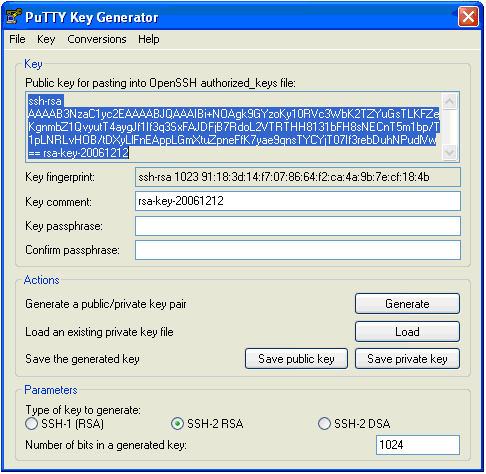Generate Rsa Key Pair In Javacard
- The following are top voted examples for showing how to use javacard.security.KeyPair.These examples are extracted from open source projects. You can vote up the examples you like and your votes will be used in our system to generate more good examples.
- Feb 22, 2016 Re: Failed to generate RSA Key. The below code also has the issue that you are trying to copy into a null buffer. The method does not allocate memory for you. You need to allocate a buffer, or use a previously allocated buffer.
I want to generate an RSA public private key pair in powershell without using external software and I want to test it. It should be able to encrypt/decrypt data on any online public/private key verification service. Purpose- Strictly Educational. I'm very well aware that you shouldn't export your private key online for security purposes. The Java KeyPairGenerator class (java.security.KeyPairGenerator) is used to generate asymmetric encryption / decryption key pairs. An asymmetric key pair consists of two keys. The first key is typically used to encrypt data. The second key which is used to decrypt data encrypted with the first key. Public Key, Private Key Type Key Pairs.
While Encrypting a File with a Password from the Command Line using OpenSSLis very useful in its own right, the real power of the OpenSSL library is itsability to support the use of public key cryptograph for encrypting orvalidating data in an unattended manner (where the password is not required toencrypt) is done with public keys.
I'm implementing a java card applet for 2048-bit RSA. I want to know how to create RSA key pair with a public exponent(e) other than 65537. The card generates RSA key pair, and return its public exponent(e) and modulus(n). But the public exponent is 65537(0x10001 in hex) every time. My code is as follows.
The Commands to Run
Generate Rsa Key Windows
Generate a 2048 bit RSA Key
You can generate a public and private RSA key pair like this:
Generate random ethereum private key location. Echoing some of the previous comments, make absolutely certain that your brainwallet password/phrase is as strong as you can construct. It should be 30 characters or longer, with no, or very few, complete words; it should incorporate multiple sources in order to compound its strength; it should incorporate at least some personal information only you know.All that being said, let's do this thing:.Create a hash of your password/passphrase, output in hexadecimal notation. You can do this using any number of tools, both online and offline.Go to the BIP39 generator created by Ian Coleman.
openssl genrsa -des3 -out private.pem 2048
That generates a 2048-bit RSA key pair, encrypts them with a password you provideand writes them to a file. You need to next extract the public key file. You willuse this, for instance, on your web server to encrypt content so that it canonly be read with the private key.
Export the RSA Public Key to a File
This is a command that is
openssl rsa -in private.pem -outform PEM -pubout -out public.pem
The -pubout flag is really important. Be sure to include it.
Next open the public.pem and ensure that it starts with-----BEGIN PUBLIC KEY-----. This is how you know that this file is thepublic key of the pair and not a private key.
To check the file from the command line you can use the less command, like this:
less public.pem
Do Not Run This, it Exports the Private Key
A previous version of the post gave this example in error.
openssl rsa -in private.pem -out private_unencrypted.pem -outform PEM
How To Generate Rsa Key
The error is that the -pubout was dropped from the end of the command.That changes the meaning of the command from that of exporting the public keyto exporting the private key outside of its encrypted wrapper. Inspecting theoutput file, in this case private_unencrypted.pem clearly shows that the keyis a RSA private key as it starts with -----BEGIN RSA PRIVATE KEY-----.
Visually Inspect Your Key Files
It is important to visually inspect you private and public key files to makesure that they are what you expect. OpenSSL will clearly explain the nature ofthe key block with a -----BEGIN RSA PRIVATE KEY----- or -----BEGIN PUBLIC KEY-----.
You can use less to inspect each of your two files in turn:
less private.pemto verify that it starts with a-----BEGIN RSA PRIVATE KEY-----less public.pemto verify that it starts with a-----BEGIN PUBLIC KEY-----
The next section shows a full example of what each key file should look like.
The Generated Key Files
The generated files are base64-encoded encryption keys in plain text format.If you select a password for your private key, its file will be encrypted withyour password. Be sure to remember this password or the key pair becomes useless.
The private.pem file looks something like this:
The public key, public.pem, file looks like:
Protecting Your Keys
Depending on the nature of the information you will protect, it’s important tokeep the private key backed up and secret. The public key can be distributedanywhere or embedded in your web application scripts, such as in your PHP,Ruby, or other scripts. Again, backup your keys!
Remember, if the key goes away the data encrypted to it is gone. Keeping aprinted copy of the key material in a sealed envelope in a bank safety depositbox is a good way to protect important keys against loss due to fire or harddrive failure.
Oh, and one last thing.
If you, dear reader, were planning any funny business with the private key that I have just published here. Know that they were made especially for this series of blog posts. I do not use them for anything else.
Found an issue?
Rietta plans, develops, and maintains applications.
Learn more about our services or drop us your email and we'll e-mail you back.
